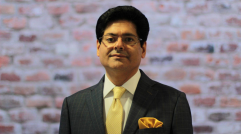San Francisco Cross-Cultural Celebration of El Día de los Muertos Unites Anglos and Latinos
Halloween and El Día de los Muertos (The Day of the Dead) are around the corner, and while both celebrations involve skeletons and graveyards, there is a distinct difference between the two -- one that goes deeper than the grave and resonates with both Anglos and Latinos.
In the United States, Halloween often involves a sugar rush and spooky, sexy or pop culture-inspired costumes, but with a growing Latino population, more Americans are acknowledging the traditional Mexican holiday and finding meaning in its powerful message.
El Día de los Muertos, which traditionally starts at midnight on the night of Oct. 31 and continues until Nov. 2, is a spiritual celebration where the living honors and celebrates the memory of loved ones who have died.
Given that its origins are distinctly Mexican, El Día de los Muertos has become one of the biggest holidays in Mexico. According to researchers its history runs deep, during the time of the Aztecs, a month-long summer celebration was overseen by the goddess Mictecacihuatl, the Lady of the Dead. After the Aztecs were conquered by Spain and Catholicism became the dominant religion, the customs became intertwined with the Christian commemoration of All Saints' Day on Nov. 1.
One of the most common customs of El Día de los Muertos is the making of elaborate altars to welcome departed spirits home. Oftentimes, vigils are held and families visit cemeteries to fix up the graves of their departed relatives. Festivities also frequently include traditional foods such as pan de muerto (bread of the dead), which can conceal a miniature skeleton.
Petaluma, Calif. is honoring the Mexican holiday with a Día de los Muertos exhibit at the Petaluma Arts Center, titled "Arbol de Vidas," or "Tree of Lives," which features artwork by both professional and community artists from Sonoma County and the rest of the Bay Area.
Traditionally, children who have died are honored Nov. 1 and deceased adults on Nov. 2, with altar displays that are often humorous, with sugar skulls and colorfully costumed skeletons, according to The Press Democrat.
"This is a common experience we have as human beings, of losing loved ones and coming together to celebrate their lives and our lives," said Virginia May, the center's administrative director. "They're still with us."
This marks the thirteenth year of the center's annual Día de los Muertos celebration, which continues to grow each year. It also includes the rest of Petaluma, with some 80 commemorative altars on display in storefronts scattered around town.
This year's program began on Oct. 5 and continues through Nov. 3, with a grand procession through downtown Petaluma from 6 to 10 p.m. Nov. 2. Last year's candlelight procession drew about 4,000 participants and spectators.
"Every year, it gets bigger and bigger," May added. "Partly, it's the passion of our organizers, and they're very careful to involve both Anglos and Latinos. It's very much about cross-cultural collaboration. That's the main goal of our event: to bridge the gap between cultures."
At the Sonoma County Museum in Santa Rosa, a Day of the Dead exhibit including work by local artists and community members will be on display until Nov. 24 in the museum's upstairs gallery.
Cynthia Conway, curator of education at Sonoma County Museum, told The Press Democrat that the exhibit draws strong support from the local Spanish-speaking community, but its audiences goes well beyond that.
Another participant, Liz Camino-Byers, who is creating an altar for the Sonoma County Museum exhibit, pointed out, "the growing popularity of El Día de los Muertos reflects greater interaction between different ethnic groups, as well as the lingering effects of the Sept. 11, 2001, terrorist attacks on America."
"I believe that Americans have been brought closer together, and mourning the loss of life is more public now," Camino-Byers said. "As communities cling together to find strength in their loss, and as they become more culturally diverse, these altars, and celebrations of the lives of those lost, are helping many families to heal."
Every culture has its own way of celebrating life and coping with death, but there is one common denominator that surpasses culture, language and race or nationality, we all live and we all die and both should be cherished.
Subscribe to Latin Post!
Sign up for our free newsletter for the Latest coverage!














